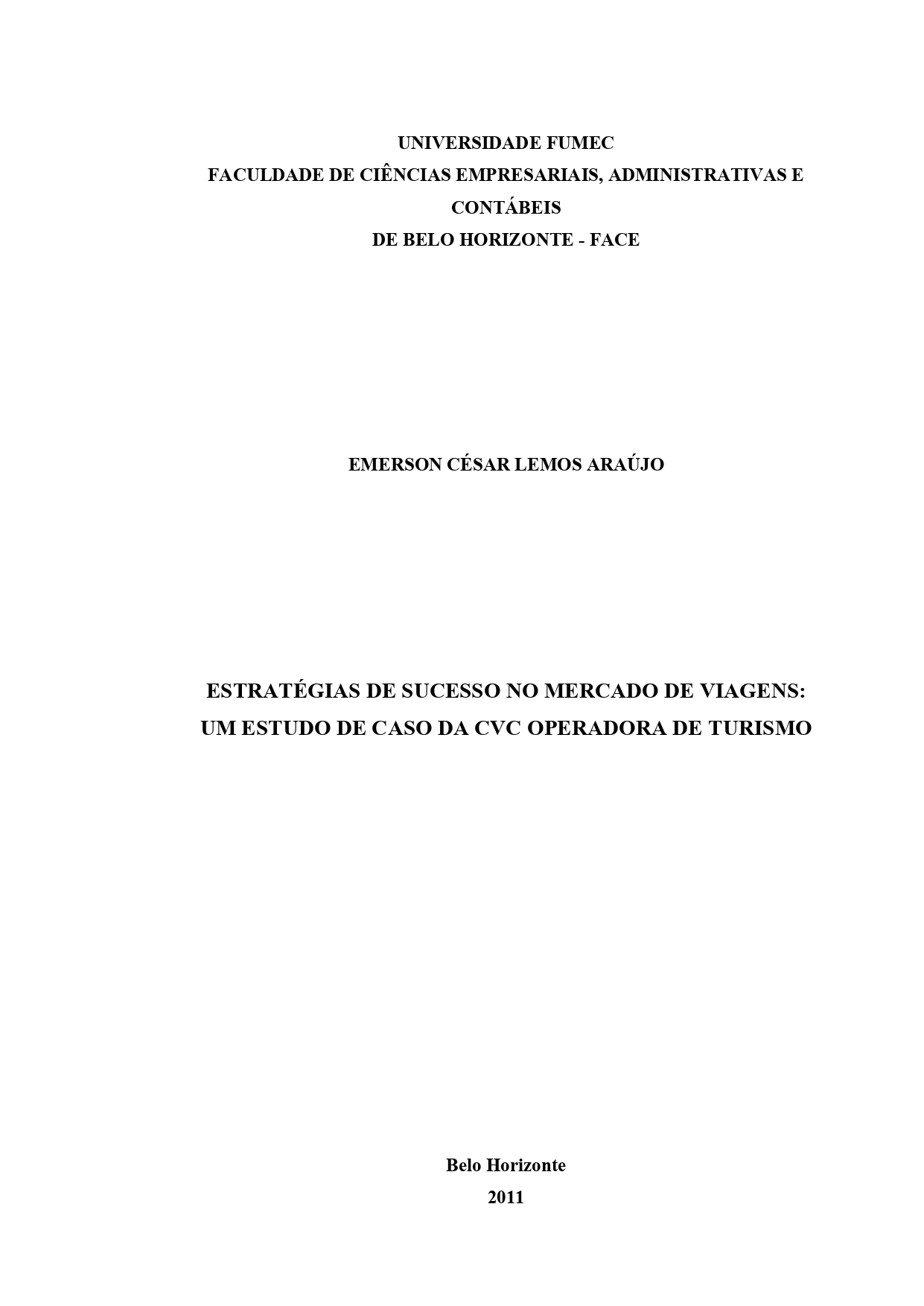Estratégias de sucesso no mercado de viagens: um estudo de caso da CVC operadora de turismo

Visualizar/
Data
2011Autor
Araújo, Emerson César Lemos
xmlui.mirage2.itemSummaryView.MetaData
Mostrar registro completoResumo
O mercado de agências de viagem e turismo se mostra como um dos mais dinâmicos e
competitivos da economia, um campo fértil para o estudo da estratégia nas suas
organizações. Com o objetivo de identificar as principais estratégias tomadas pela CVC
ao longo de sua história e, dessa forma, ampliar a produção de conhecimento sobre as
estratégias que levam ao sucesso das organizações desse setor, é apresentado um estudo
de caso da CVC Operadora de Turismo, uma das dez maiores operadoras de turismo no
mundo (World Travel Market, 2009) e referência nacional e internacional no mercado
de viagens. O método utilizado foi a junção entre a pesquisa documental - que levantou
informações-chave sobre a trajetória de crescimento da empresa, seu mercado e
principais estratégias adotadas nas pastas de inovação, marketing, recursos humanos e
concorrência - e a pesquisa bibliográfica, que forneceu a base teórica necessária para
definir o que se toma por estratégias de sucesso nas operadoras de viagem e turismo,
baseada nas características endógenas deste mercado e nas tendências para o setor. Os
resultados alcançados sugerem que a CVC construiu seu crescimento pautado em
inovações sistemáticas em produto e processo, mantendo uma vantagem competitiva
sustentável, fruto da posição estratégica de first mover. Na pasta de marketing, as
estratégias de sucesso consistem principalmente na diversificação do portfólio de
produto, com vistas a atender vários segmentos da demanda, na diversificação
geográfica, no fortalecimento da marca com altos investimentos em publicidade e o
perfil conservador, porém agressivo na distribuição, com incentivo a expansão das lojas
físicas, tanto exclusivas quanto agências credenciadas. Na área de recursos humanos,
nota-se uma visível preocupação com o treinamento e capacitação de sua linha de
frente, composta por quase seis mil agentes de viagem. Quanto à concorrência, o foco
estratégico no turismo interno foi entendido como causa fundamental da sobrevivência e
consolidação da CVC frente aos seus principais competidores e, ao se utilizar o modelo
das Cinco Forças de Porter (1999) para análise atual da indústria, verificou-se que a
CVC encontra-se em posição confortável no mercado, com grandes oportunidades para
o futuro, mas também ameaças, pela possibilidade de entrada de grandes concorrentes
internacionais e pela ascensão das agências de turismo virtual no mercado de viagens
brasileiro. The market of travel agencies and tourism appears as one of the most dynamic and
competitive of the economy, a fertile field for the study of strategy in their
organizations. In order to identify the main strategies taken by the CVC along its history
and thus increase the production of knowledge about the strategies that lead to success
in this sector organizations, is presented a case study of CVC Tour Operator, one of the
ten largest tour operators in the world (World Travel Market, 2009) and a national and
international reference on travel market. The method used was the junction between the
documentary research - which raised key information about the trajectory of growth of
the company, its market and the main strategies adopted in the folders of innovation,
marketing, human resources and competition - and the literature research, which
provided the theoretical basis necessary to define what is successful strategies in the
travel and tourism operators, based on endogenous characteristics of this market and its
industry trends. The results suggest that the CVC has built its growth process based on
systematic innovation in products and processes, maintaining a sustainable competitive
advantage, resulting from the strategic position of first mover. In the folder of
marketing, success strategies are primarily the diversification of product portfolio, in
order to meet various segments of demand, geographical diversification, strengthening
of the brand with high investments in advertising and a conservative, but aggressive in
distribution, encouraging the expansion of physical stores, both exclusive and
accredited agencies. In the area of human resources, there is a visible concern for the
development and training of their front line, consisting of nearly six thousand travel
agents. On competition, the strategic focus on domestic tourism was seen as the root
cause of the survival and consolidation of CVC against its major competitors and, when
using the Five Forces model of Porter (1999) to analyze current industry, there was the
CVC is in a comfortable position in the market with great opportunities for the future,
but also threats, the possibility of entry of large international competitors and the rise of
virtual travel agencies in the Brazilian travel market.
